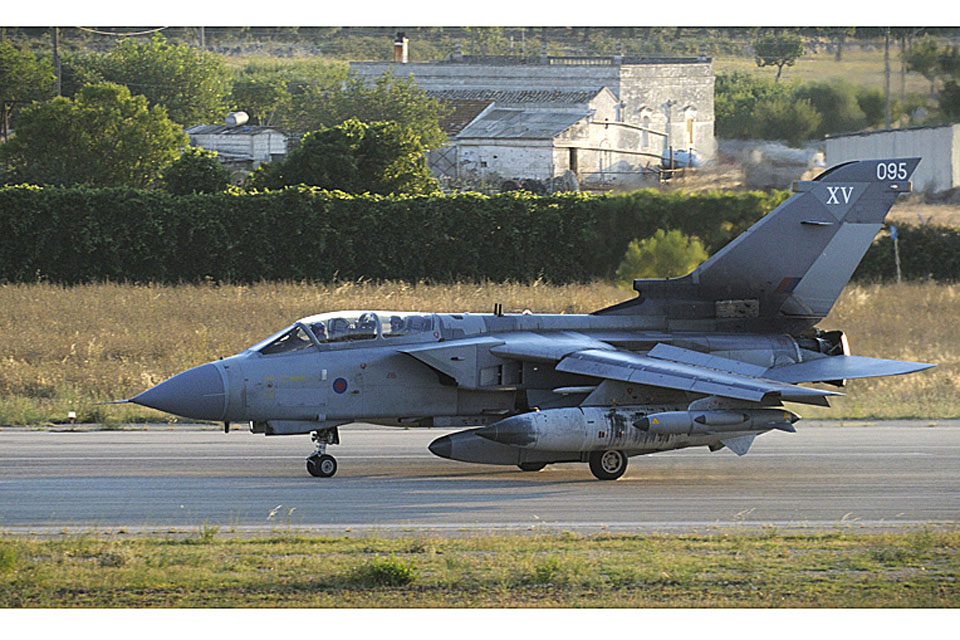RAF strikes Gaddafi targets in Tripoli
RAF aircraft bombed a key intelligence building in Tripoli and breached the walls of Colonel Gaddafi's command complex this weekend, and inflicted further losses on pro-Gaddafi forces massed at Zlitan and Gharyan.

A Royal Air Force Typhoon lands at Gioia del Colle, southern Italy, after a mission over Libya (stock image) [Picture: Sergeant Pete Mobbs, Crown Copyright/MOD 2011]
In the early hours of Sunday morning, 24 July, RAF Tornado and Typhoon aircraft conducted a precision strike on the Central Organisation for Electronic Research (COER). Major General Nick Pope, the Chief of the Defence Staff’s Communications Officer, said:
Ostensibly an engineering academy, the COER has, in reality, long been a cover for the regime’s nefarious activities. Up until Colonel Gaddafi’s renunciation of weapons of mass destruction in 2003, the COER was responsible for his long-range missile development programme.
Intensive surveillance by NATO over the past weeks revealed that the building was still being actively used by his security apparatus to repress the civilian population, and was thus a wholly legitimate target.
Also on Sunday morning, other RAF jets successfully attacked two staging posts near Zlitan being used to muster tanks, rocket artillery and ammunition. Later that afternoon, an armed reconnaissance patrol located and destroyed a regime main battle tank near Gharyan, on the edge of the Djebel Nafousa, south of Tripoli.
On Saturday, 23 July, RAF aircraft used precision guided weapons to breach the walls of Colonel Gaddafi’s command complex in central Tripoli.
General Pope said:
Gaddafi has for decades hidden from the Libyan people behind these walls. The vast Bab al-Aziziya compound is not just his personal residence, but, more importantly, is also the main headquarters for his regime, with command and control facilities and an army barracks all part of the same fortified site.
Successive NATO strikes in past weeks have inflicted extensive damage on the military facilities within.
In the early hours of Saturday morning, RAF Tornado and Typhoon aircraft, supported by allied aircraft, struck the high perimeter walls of the compound, which have for so long been such an unwelcome symbol to the people of Tripoli of Gaddafi’s despotic rule.
Paveway guided bombs scored direct hits in thirteen different places on both the outer and inner perimeter walls along the western side of Bab al-Aziziya. As ever, particular care was taken to ensure no civilian traffic on nearby roads was endangered.
Also on Saturday, RAF jets on patrol near Zlitan successfully struck four buildings which NATO surveillance missions had confirmed were being used as a command and control centre and a staging post for regime troops being mustered for attacks on the people of Libya.
Armed reconnaissance patrols continued in the area throughout the day, and, during Saturday night, RAF aircraft were able to conduct a precision strike on a large ammunition stockpile. In addition, HMS Ocean launched her Army Apache helicopters against a number of military positions between Zlitan and Al Khums, which were successfully engaged using Hellfire missiles.

An RAF Tornado GR4, flown by a crew from 12 Squadron, with RAPTOR (Reconnaissance Airborne Pod for Tornado) intelligence-gathering capability taxis on the runway at Gioia del Colle, southern Italy [Picture: Corporal Pete Devine RAF, Crown Copyright/MOD 2011]
On Thursday afternoon, 21 July, RAF aircraft patrolling near Zlitan identified and destroyed a self-propelled anti-aircraft gun. During the night, British Army Apache helicopters once again launched a strike mission from HMS Ocean, while other NATO aircraft provided overwatch.
Two buildings being used by regime troops at Al Khums were damaged by Hellfire missiles. This strike was followed up by NATO fixed-wing aircraft in the early hours of Friday morning; RAF jets hit six ammunition storage facilities near Zlitan, and a large building that was being used as a base for multiple rocket launchers threatening Misurata.
In addition, one deployed rocket launcher and two armed trucks were destroyed.
On Friday afternoon, 22 July, further RAF armed reconnaissance patrols successfully engaged one of Gaddafi’s tanks and another armed truck, again near Zlitan.
Throughout these operations, NATO tanker and surveillance assets provided essential support, including RAF VC10, Tristar, Sentry and Sentinel aircraft.
At sea, the frigate HMS Iron Duke has been relieved on station by her sister ship HMS Sutherland. HMS Bangor continues to provide NATO’s maritime task group with a vital mine countermeasures capability, ready to respond to any attempts by the regime to again lay mines off Misurata port.
Since the start of military operations to enforce UNSCR 1973, Royal Navy, Royal Air Force and Army Air Corps precision strikes have destroyed over 710 regime targets engaged in the repression of the Libyan people.
UK missions over Libya are undertaken as part of NATO’s Operation UNIFIED PROTECTOR, to enforce UNSCR 1973 and protect Libyan civilians at risk of attack.
UK forces currently deployed on this operation include:
- RAF Tornado and Typhoon aircraft based at Gioia del Colle in Italy
- RAF VC10 and Tristar air-to-air refuelling tankers, based in Sicily, Cyprus and the UK
- RAF Sentry and Sentinel surveillance aircraft, based in Sicily and Cyprus
- HMS Ocean (helicopter carrier)
- HMS Sutherland (Type 23 frigate)
- HMS Bangor (Sandown class minehunter)
- Royal Fleet Auxiliary Fort Rosalie
- British Army Apache attack helicopters
- Fleet Air Arm Sea King helicopters (Airborne Surveillance and Area Control role).
RAF air transport aircraft provide extensive logistic support to the deployed bases in Italy, Sicily and the Sovereign Base Areas in Cyprus.